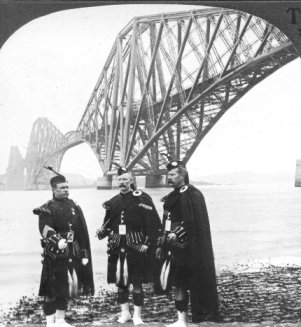A Tale of Three Bridges
Today, an ominous tale of three designers and three bridges. The University of Houston's College of Engineering presents this series about the machines that make our civilization run, and the people whose ingenuity created them.
The 46-mile rail trip from Edinburgh to Dundee took half a day in 1870. You had to ride the ferry over two wide fjords that slice into Scotland -- the Firth of Tay and Firth of Forth. Henry Petroski tells how an English engineer, Thomas Bouch, sold backers on building bridges over those inlets.
The first was an immense two-mile bridge over the Firth of Tay. When its 85 spans were finished in 1877, they made up the longest bridge in the world. And Queen Victoria knighted Bouch.
Then, disaster! The Tay Bridge collapsed in 1879, killing seventy-five people including Bouch's son-in-law. Cost-cutting had yielded a bridge that couldn't stand up to the wind forces. Bouch died in humiliation four months later.
By 1881 the Tay Bridge was rebuilt with heavy unbeautiful trusses, and attention turned to the Firth of Forth. It was a mile wide, with only one shallow spot for a central pier. It would require two huge half-mile spans. How to proceed?
An engineer named Benjamin Baker rallied public support for a new kind of bridge: triangular structures reaching out from opposite sides to hold central spans in the middle. That cantilever construction was still radical in 1881. And Baker's Firth of Forth design was a striking array of massive tubular steel members.
While Bouch and Baker struggled to link Edinburgh and Dundee, a young American bridge builder, Theodore Cooper, watched and learned. When the first Tay Bridge fell he was 40 -- a seasoned designer just opening a consulting office in New York. Cooper was known for hands-on care in his work. He knew not to be careless the way Bouch had been. He knew to stay on top of the work.
In 1887, as Baker's Firth of Forth Bridge was going up, the Canadian Government set out to bridge the St. Lawrence River at Quebec -- another wide inlet, splitting southern Canada!
Like Baker, Cooper designed a cantilever bridge. But years of success had buoyed his belief in saving money on material. His Quebec bridge was light and buoyant, and it was to be the longest cantilever structure ever made. By 1907, its delicate girders reached, unsupported, 900 feet over the water.
But Cooper was now 68 and America's leading bridge designer. He'd grown content to sit in New York directing the work by telegram. When a wire warned that beams were buckling, he didn't react in time. The arm collapsed, and 73 workers fell to their deaths.
And so history repeated itself. Success following failure, and failure following success. That's a cycle we forget at our peril. Today, all three inlets have their bridges. But, of the three, the Firth of Forth Bridge, built in disaster's wake, was the one that did not have to suffer a collapse. It was the only one built in the right phase -- of that murderous cycle.
I'm John Lienhard, at the University of Houston, where we're interested in the way inventive minds work.
(Theme music)
Petroski, H., Engineers of Dreams: Great Bridge Builders and the Spanning of America. New York: Alfred A. Knopf, 1995, Chapter III, Cooper.
I am grateful to Dominic Creek from the University at Karlsruhe for additional information about the Tay Bridge failure.

Schematic sketch of a portion of Baker's Firth of Forth Bridge
From the 1897 Encyclopaedia Britannica

A less starkly practical view of the bridge
Stereopticon image courtesy of Margaret Culbertson